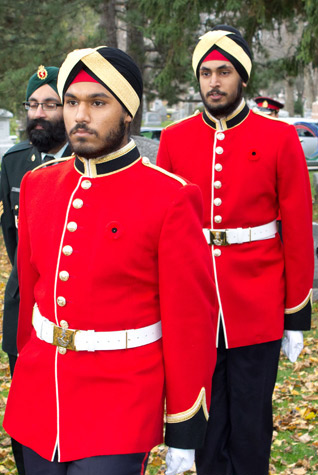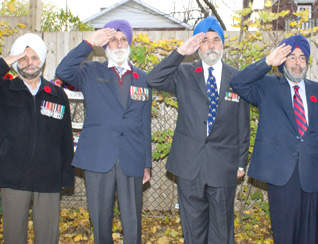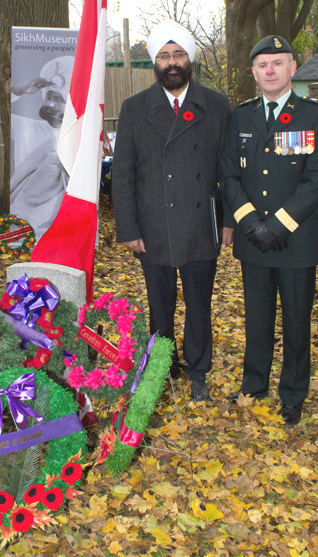
All images are from the Sikh Remembrance Day Ceremony, November 4, 2012. Courtesy: www.SikhMuseum.com.



Current Events
Thoughts on War ... and Peace:
The Sikh Remembrance Day
SANDEEP SINGH BRAR
Yesterday (Sunday, November 4, 2012), as we gathered at the grave of Pvt. Buckam Singh at Mount Hope Cemetery in Waterloo (Ontario, Canada), for the 5th Annual Sikh Remembrance Day Ceremony, my thoughts turned to the nature of war.
Are we glorifying war when we have these kinds of events?
The Sikh Remembrance Day Ceremony has three objectives:
1 To remember Sikh-Canadian war hero Pvt. Buckam Singh;
2 To honour all soldiers who serve, have served, and those who have paid the ultimate sacrifice for Canada and the world; and
3 To celebrate the Sikh tradition of military service, a tradition that dates back 400 years to the time of our Sixth Master, Guru Hargobind.
Over a hundred of us gathered in the bitter cold, along with members of the Canadian Forces, for the ceremony. It was so uplifting to see the faces of young Sikh soldiers in today’s Canadian military. The bright red uniforms of the first turbanned Officer Cadets in the history of the Royal Military College fit right in with the brilliant colors of the fall leaves scattered at our feet throughout the cemetery.
The fact that the Canadian Forces had even sent a Brigadier-General from Ottawa to attend our ceremony, just underlined how much respect Sikhs have in the Canadian military today.
As part of the Sikh Remembrance Day activities this year, I had set up a Sikh Military Heritage Exhibit that showcased our military tradition from the time of Maharaja Ranjit Singh and the Khalsa Army to our contributions in World Wars I and II.
Last week at the exhibit a reporter from the Indian media who was interviewing me asked that ‘was I not glorifying the military in a day and age of peace and non-violence?’ A valid question, but one that did preoccupy my thoughts for a while.
Thinking about it at the Sikh Remembrance Day Ceremony in the presence of the Canadian Forces and elderly Sikh military veterans, I would answer that question by asking another question: How do you think peace has been achieved?
Just imagine what a different world it would be today if Sikhs and Canadians had not joined the war effort in World War II to destroy Hitler’s ideas of achieving a master race by enslaving and exterminating millions.
During a 1937 meeting in Nazi Germany between Lord Halifax, Britain's Foreign Secretary, and Adolf Hitler, the latter expressed astonishment over political unrest in India. ‘All you have to do’, he said, by way of a solution, ‘is to shoot Gandhi. If necessary, shoot more leaders of Congress. You will be surprised how quickly the trouble will die down’.
So, given how highly you think of Mohandas Gandhi’s ideas of non-violent protest or pacifism, would it have worked against the brutality of Nazi Germany? Not too well, it seems.
How well did Mohandas Gandhi’s ideas of non-violence and pacifism work out during the 1947 Partition of Punjab and India that saw the death of anywhere from half a million to two million people? Not too well.
At the start of World War II, Canadians were asking why should Canada fight against Germany and Japan. Canada was not at direct risk, so why send our military to fight someone else’s war? These questions asked more than half a century ago, seem very familiar to most of us today, don’t they?
We heard those same questions when Canadian troops were deployed to Afghanistan as part of an international effort to combat terrorism following 911.
Why we need militaries today and why we have needed them in the past and why we have chosen to fight in other lands were valid questions as Canada entered World War II. Studying a speech given by Canadian Prime Minister Mackenzie King in 1942, I found the answers to these questions which are as valid today as they were when this speech was delivered over 70 years ago. Part of what Prime Minister King had to say in his speech was:
“Here surely is the most powerful of reasons why every effort should be made, as it is being made, alike by the United States and Canada, to help the other united nations to engage the enemy and try to defeat him where he is to be found today. We cannot defend our country and save our homes and families by waiting at home for the enemy to attack us. Every country that has stood behind its own defences in this war has sooner or later been attacked. To remain on the defensive is the surest way to bring the war to Canada.
"Of course, we should look to our defenses; we should protect our coasts; we should strengthen our ports and our cities against attack. But we must also take our full part in the combat, we must go out to meet the enemy before he reaches our shores; we must, if we can, defeat him before he attacks us, before our cities are laid waste and before the women and children of Canada are injured or killed in our streets and our homes …
"It is unfortunate that so many have come to think of Canada's war effort as aid for other countries. In reality, it is much more than that. Every sailor, every soldier, every airman in Canada's forces, wherever they serve; every ship, every gun, every plane we manufacture, regardless of the forces that use them; the food we supply to our allies; all these may be aid to other countries against a common enemy, but are equally a contribution to the defense of Canada.
"Let no one tell you that Canada is in this war to uphold any selfish cause of empire. It is not true. We are fighting to preserve our freedom and our national existence, to defend our homes and families, from an enemy drawing ever nearer.”
Some things may change over time, but why we fight, why we sacrifice and why we honour our military with events like the Sikh Remembrance Day Ceremony remain the same as they were when the Prime Minister uttered those words in 1942.
A man of God, a military pastor once wrote the following poem:
“It is the soldier, not the reporter who has given us the freedom of the press.
It is the soldier, not the poet, who has given us the freedom of speech.
It is the soldier, not the campus organizer, who gives us the freedom to demonstrate.
It is the soldier who salutes the flag,
Who serves beneath the flag, and whose coffin is draped by the flag,
Who allows the protester to burn the flag.”
I think of that poem when someone asks if Remembrance Day is important or if remembering our Sikh military heritage and history are still important. I think of how many have sacrificed so that we can live in peace and as free people here in Canada today.
I think about the 619,000 Canadians and 65,000 Sikhs that fought in World War I and I think of the 1.1 million Canadians and the 300,000 Sikhs that fought against Nazi Germany and Imperial Japan in World War II.
There is a lot to think about, to remember and to celebrate at the annual Sikh Remembrance Day Ceremony as we gather in this military cemetery each year.
And on Remembrance Day next Sunday, November 11, 2012.
The author organizes the annual Sikh Remembrance Day Ceremony. For more details, please CLICK here.
November 5, 2012
Conversation about this article
1: Harmeet Singh (USA), November 05, 2012, 12:43 PM.
Sandeep ji: How do you deal with the purported edict by Guru Gobind Singh on marhis or graves? I m not sure if it has any validity, but it is commonly ascribed to Guru Gobind Singh.
2: Tarun Preet Singh (Perth, Australia), November 06, 2012, 2:31 AM.
I have been reading your articles off and on. I would also like to update you that Sikhs died in Australia during the Second World War as well. A young pilot Manmohan Singh sacrificed his life during the Japanese air raids in Broome in Western Australia on 03 March 1942. Sikh Association of Western Australia is planning to honour him and give this forgotten hero his due place in history.
3: Gursimran Kaur (Mohali, Punjab), November 07, 2012, 9:55 AM.
@Harmeet Singh - Veerji, I think the edict by Guru Sahib was against the 'worshiping' of graves. It was against the ideology that made people believe that graves have supernatural or black magical powers. I feel the above article deals with using graves as a symbol to 'remember' and celebrate our great heritage and thus is definitely not something that violates the Sikh code of conduct. @Tarun Preet Singh - Thanks for this valuable piece of information.
4: Harinder (Jalandhar, Punjjab), November 09, 2012, 1:04 AM.
Well said, Sandeep ji.
5: Kay (USA), January 29, 2013, 9:04 PM.
The Sikh religion is very beautiful. I am grateful for the Sikh soldiers who helped preserve freedom in WWl and WWll. I would like to learn more about the Sikh Religion and Scripture.


